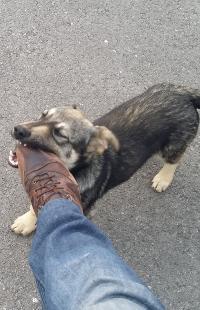Determining Angular Scale - Help w/ Microsteps
- notJamesLee
- Offline
- Senior Member
-

Less
More
- Posts: 60
- Thank you received: 5
16 Apr 2025 15:34 #326468
by notJamesLee
Replied by notJamesLee on topic Determining Angular Scale - Help w/ Microsteps
No, sorry i should've explain it better. Its just one belt.
The reason there are two loops; i only had a few closed loop belt size (length) options off the shelf from amazon, i needed to make sure the tensioner i was designing could make putting one of those belts on easier. So you'll see a one 'loop' goes around the interior most path and the opposite it true for the outer path.
Its one belt around three components, motor, driveshaft, tensioner. i attached a smaller slice, hopefully my rambles make sense.
The reason there are two loops; i only had a few closed loop belt size (length) options off the shelf from amazon, i needed to make sure the tensioner i was designing could make putting one of those belts on easier. So you'll see a one 'loop' goes around the interior most path and the opposite it true for the outer path.
Its one belt around three components, motor, driveshaft, tensioner. i attached a smaller slice, hopefully my rambles make sense.
Please Log in or Create an account to join the conversation.
- langdons
-

- Offline
- Platinum Member
-

Less
More
- Posts: 745
- Thank you received: 83
16 Apr 2025 16:20 #326471
by langdons
Replied by langdons on topic Determining Angular Scale - Help w/ Microsteps
Why?
Wouldn't a regular single belt directly from pulley to pulley suffice?
I think the tensioner will mess with stuff b/c the load is bi-directional.
Are the belts on top of one-another?
That must cause wierd stuff to happen b/c the belts on the outside will move faster.
One loop of a single belt, going pulley -> tensioner -> pulley -> tensioner should work better.
Avoid unnecessary complexity.
Simplicity is beatiful.
Wouldn't a regular single belt directly from pulley to pulley suffice?
I think the tensioner will mess with stuff b/c the load is bi-directional.
Are the belts on top of one-another?
That must cause wierd stuff to happen b/c the belts on the outside will move faster.
One loop of a single belt, going pulley -> tensioner -> pulley -> tensioner should work better.
Avoid unnecessary complexity.
Simplicity is beatiful.
Please Log in or Create an account to join the conversation.
- tommylight
-

- Away
- Moderator
-

Less
More
- Posts: 20944
- Thank you received: 7134
16 Apr 2025 16:25 #326473
by tommylight
Replied by tommylight on topic Determining Angular Scale - Help w/ Microsteps
That is a single belt in that drawing, it just shows where it would be when tightened completely.
And he already mentioned he is using a single belt...
And he already mentioned he is using a single belt...
The following user(s) said Thank You: notJamesLee
Please Log in or Create an account to join the conversation.
- notJamesLee
- Offline
- Senior Member
-

Less
More
- Posts: 60
- Thank you received: 5
16 Apr 2025 17:25 #326480
by notJamesLee
Replied by notJamesLee on topic Determining Angular Scale - Help w/ Microsteps
correct, thank you.
I wanted a closed loop belt for a lot of reasons. Its next to impossible to get on a closed loop belt without some sort of tensioning device.
I am with you on avoiding complexity, this is the third rev of this cutting head for that exact reason.
I wanted a closed loop belt for a lot of reasons. Its next to impossible to get on a closed loop belt without some sort of tensioning device.
I am with you on avoiding complexity, this is the third rev of this cutting head for that exact reason.
Please Log in or Create an account to join the conversation.
- notJamesLee
- Offline
- Senior Member
-

Less
More
- Posts: 60
- Thank you received: 5
16 Apr 2025 18:42 - 16 Apr 2025 18:43 #326485
by notJamesLee
Replied by notJamesLee on topic Determining Angular Scale - Help w/ Microsteps
Friends,
from what I can only assume is inconsistencies in diameter or something but 533.33 is the number.
with 533 after 20+ revolutions you can see the starting point creep earlier -- indicating its just short of the number of steps to complete a full circle.
with 534 after 20+ it goes the opposite way.
I have a few follow up questions:
- what should i have the dip switches set to? Now that we've figured out they don't do anything to effect the steps per revolution is there an optimal value for this? I dont need insane amounts of torque or rpms
- is this something i can easily fix with the encoder once i do move to LCNC and tune in the encoder error?
thanks all for sanity checking me thus far, nice to know im not 100% crazy.
from what I can only assume is inconsistencies in diameter or something but 533.33 is the number.
with 533 after 20+ revolutions you can see the starting point creep earlier -- indicating its just short of the number of steps to complete a full circle.
with 534 after 20+ it goes the opposite way.
I have a few follow up questions:
- what should i have the dip switches set to? Now that we've figured out they don't do anything to effect the steps per revolution is there an optimal value for this? I dont need insane amounts of torque or rpms
- is this something i can easily fix with the encoder once i do move to LCNC and tune in the encoder error?
thanks all for sanity checking me thus far, nice to know im not 100% crazy.
Last edit: 16 Apr 2025 18:43 by notJamesLee.
Please Log in or Create an account to join the conversation.
- langdons
-

- Offline
- Platinum Member
-

Less
More
- Posts: 745
- Thank you received: 83
17 Apr 2025 12:28 #326518
by langdons
Replied by langdons on topic Determining Angular Scale - Help w/ Microsteps
Ok. Single belt.
Does it need two tensioners, one on each for consitency?
Does it need two tensioners, one on each for consitency?
Please Log in or Create an account to join the conversation.
- langdons
-

- Offline
- Platinum Member
-

Less
More
- Posts: 745
- Thank you received: 83
17 Apr 2025 12:29 #326519
by langdons
Replied by langdons on topic Determining Angular Scale - Help w/ Microsteps
Really bizzare.
Try the motor sans belt, draw a notch on the pulley attached to the motor and count how many revolutions it makes.
Try the motor sans belt, draw a notch on the pulley attached to the motor and count how many revolutions it makes.
Please Log in or Create an account to join the conversation.
- spumco
- Offline
- Platinum Member
-

Less
More
- Posts: 1954
- Thank you received: 792
17 Apr 2025 16:33 #326528
by spumco
Sounds like you're still struggling with the driver, yes?
Maybe I missed it, but what brand/model driver do you have? Asking because some drivers can be tuned via software (in addition to dip switches), and there may be a setting (or another dip) that disables the external dip switches.
Replied by spumco on topic Determining Angular Scale - Help w/ Microsteps
Friends,
from what I can only assume is inconsistencies in diameter or something but 533.33 is the number.
with 533 after 20+ revolutions you can see the starting point creep earlier -- indicating its just short of the number of steps to complete a full circle.
with 534 after 20+ it goes the opposite way.
I have a few follow up questions:
- what should i have the dip switches set to? Now that we've figured out they don't do anything to effect the steps per revolution is there an optimal value for this? I dont need insane amounts of torque or rpms
- is this something i can easily fix with the encoder once i do move to LCNC and tune in the encoder error?
thanks all for sanity checking me thus far, nice to know im not 100% crazy.
Sounds like you're still struggling with the driver, yes?
Maybe I missed it, but what brand/model driver do you have? Asking because some drivers can be tuned via software (in addition to dip switches), and there may be a setting (or another dip) that disables the external dip switches.
Please Log in or Create an account to join the conversation.
- langdons
-

- Offline
- Platinum Member
-

Less
More
- Posts: 745
- Thank you received: 83
17 Apr 2025 21:42 #326547
by langdons
Replied by langdons on topic Determining Angular Scale - Help w/ Microsteps
forum.linuxcnc.org/media/kunena/attachme..._Full_Datasheet3.pdf
www.omc-stepperonline.com/download/CL42T...5m5IfKGqiz1_MkyzY52P
By the way, please consider posting links to external websites instead of attaching files, whenever possible.
LinuxCNC's forum server will thank you for the reduced load.
www.omc-stepperonline.com/download/CL42T...5m5IfKGqiz1_MkyzY52P
By the way, please consider posting links to external websites instead of attaching files, whenever possible.
LinuxCNC's forum server will thank you for the reduced load.
The following user(s) said Thank You: spumco, notJamesLee
Please Log in or Create an account to join the conversation.
- spumco
- Offline
- Platinum Member
-

Less
More
- Posts: 1954
- Thank you received: 792
18 Apr 2025 02:00 #326556
by spumco
Replied by spumco on topic Determining Angular Scale - Help w/ Microsteps
So it looks like the drive is software-configurable.
I'd suggest going back to basics and connecting the drive to a Windows PC and verifying all the drive settings via the drive tuning software.
SIDE NOTE: make sure the motor's encoder count (1000/4000) matches what the drive is expecting.
Set the dip switches to 'software' (i.e. all ON). The reason is that you can (probably) set the microsteps to a useful number in software and are not limited to one of the 200/800/1600/etc values as with dip switches.
This will allow you to set the microstepping to a value that makes the steps per spindle rev a whole number, making the math for LCNC much easier.
Since LCNC's rotary axes units are set in INI [TRAJ] ANGULAR_UNITS = DEGREES, you need the [JOINT_N] STEP_SCALE to be in steps per degree.
For a 3:1 belt reduction and a 1.8deg motor, if you set the microsteps to 2400/rev (12x microsteps), you will wind up with 20 steps per spindle degree.
If you find that 12x is too fine and the positional accuracy is kinda 'ish', you can go down to 1200/rev (6x) and adjust INI to 10 steps per degree. That might give the drive a bit more of a chance to hit a particular position rather than somewhere close-ish on either side of the target. Either way you're still below the encoder's resolution so the drive isn't going to be totally guessing on a position.
And while you're in there, you should adjust the drive's following error tolerance. I've found that Stepperonline's drives have a following error alarm set extremely high. As in the motor could be 1/2 a full rotation out of position before it alarms out - not OK for CNC use.
I'd suggest going back to basics and connecting the drive to a Windows PC and verifying all the drive settings via the drive tuning software.
SIDE NOTE: make sure the motor's encoder count (1000/4000) matches what the drive is expecting.
Set the dip switches to 'software' (i.e. all ON). The reason is that you can (probably) set the microsteps to a useful number in software and are not limited to one of the 200/800/1600/etc values as with dip switches.
This will allow you to set the microstepping to a value that makes the steps per spindle rev a whole number, making the math for LCNC much easier.
Since LCNC's rotary axes units are set in INI [TRAJ] ANGULAR_UNITS = DEGREES, you need the [JOINT_N] STEP_SCALE to be in steps per degree.
For a 3:1 belt reduction and a 1.8deg motor, if you set the microsteps to 2400/rev (12x microsteps), you will wind up with 20 steps per spindle degree.
If you find that 12x is too fine and the positional accuracy is kinda 'ish', you can go down to 1200/rev (6x) and adjust INI to 10 steps per degree. That might give the drive a bit more of a chance to hit a particular position rather than somewhere close-ish on either side of the target. Either way you're still below the encoder's resolution so the drive isn't going to be totally guessing on a position.
And while you're in there, you should adjust the drive's following error tolerance. I've found that Stepperonline's drives have a following error alarm set extremely high. As in the motor could be 1/2 a full rotation out of position before it alarms out - not OK for CNC use.
The following user(s) said Thank You: notJamesLee
Please Log in or Create an account to join the conversation.
Time to create page: 0.080 seconds
